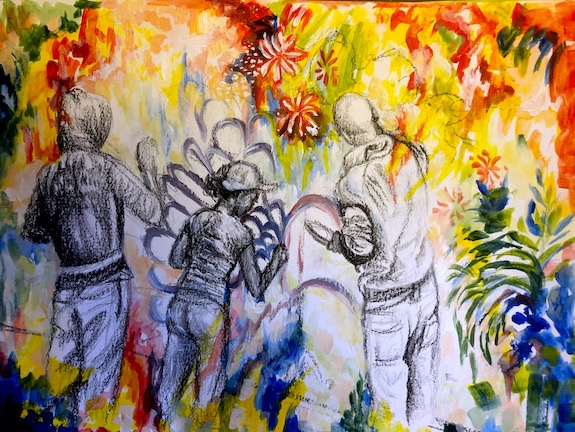Rapprochements entre souvenirs et récits transformateurs : réponse visuelle et écrite à Art-making with refugees and survivors par Sally Adnams Jones
Contenu principal de l'article
Résumé
Réaction livresque: Art-making with refugees and survivors: Creative and transformative responses to trauma after natural disasters, war, and other crises, edited by Sally Adnams Jones. London, England: Jessica Kingsley Publishers, 2018, 336 pp., ISBN: 1785922386
Mots-clés : arts communautaires ; réfugiés et survivants ; arts internationaux ; thérapies par des activités créatives et d’expression ; éducation artistique ; transformateur.
Téléchargements
Renseignements sur l'article

Cette œuvre est protégée sous licence Creative Commons Attribution - Partage dans les Mêmes Conditions 4.0 International.
The copyright notice is CC BY SA.
This license lets others remix, tweak, and build upon your work even for commercial purposes, as long as they credit you and license their new creations under the identical terms. All new works based on yours will carry the same license. Thus any derivatives will also allow commercial use. For example, if someone translates your article into French, the French version of the article will also have to be shared under a CC BY SA license.
Références
Boal, A. (1979). Theatre of the oppressed. New York, NY: Theatre Communications Group.
Csikszentmikalyi, M. (1990). Flow: The psychology of optimal experience. New York, NY: Harper Perennial Modern Classics.
Csikszentmikalyi, M. (1996). Creativity: Flow and psychology of discovery and invention. New York, NY: Harper Collins.
Frankl, V. (2006). Man’s search for meaning. Boston, MA: Beacon Press.
Freire, P. (1970). Pedagogy of the oppressed. New York, NY: Bloomsbury.
Greene, M. (1977). Imagination and aesthetic literacy. Art Education, 20(6), 14-20.
Greene, M. (1995). Releasing the imagination: Essays on Education, the arts, and social change. San Francisco, CA: John Wiley & Sons.
Jung, C. G. (2009). The red book: Liber Novus. New York, NY: W. W. Norton.
Kapitan, L. (2015). Social action in practice: Shifting the ethnocentric lens in cross-cultural art therapy encounters. Art Therapy: Journal of the American Art Therapy Association, 32(3), 104–111.
Maslow, A. H. (1954). Motivation and personality. New York, NY: Van Nostrand-Reinhold.
McNiff, S. (1992). Art as medicine: Creating a therapy of the imagination. Boston, MA: Shambhala Publications.
McNiff, S. (2004). Art heals: How creativity cures the soul. Boston, MA: Shambhala.
Potash, J. S., Bradot, H., Moon, C. H., Napoli, M., Lyonsmith, A., & Hamilton, M. (2017). Ethical implications of cross-cultural international art therapy. The Arts in Psychotherapy, 56, 74-81. Doi: http://dx.doi.org/10.1016/j.aip.2017.08.005
United Nations High Commissioner for Refugees (2018). Global trends: Forced displacement in 2017. Geneva, Switzerland: UNHCR. Retrieved from www.unhcr.org/en-us/statistics/ unhcrstats/5b27be547/unhcrglobal-trends-2017.html.
Van der Kolk, B. (2014). The body keeps the score: Brain, mind, and body in the healing of trauma. New York, NY: Viking Publishers.
World Refugee Council. (2019). A call to action: Transforming the global refugee system. Retrieved on May 30, 2019 from https://www.cigionline.org/sites/default/files/documents/WRC_Call_to_Action.pdf

